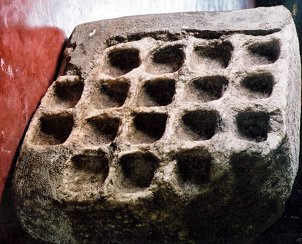
In 1840, Major Forbes uncovered a yantra gala among the ruins of the dāgaba nearby. He reports that he found it “Amidst its scattered fragments. It is “A stone cut into twenty-five compartments; in the center on of these the relic of the Buddha had been placed, and the remaining cells in the stone had contained the offerings made when the relic was deposited.”(P. No.346). The custom of building dāgabas in the third Century BC involved the enshrining a yantra gala of a dāgaba. Chatra gala is another artifact found here. It is a circular stone of a three and a half metre diameter used in place of an umbrella for the dāgaba. This had served as a canopy and resembled to the one Sānci stupa has in India. These ancient findings are presently deposited in the International Buddhist Library and Museum at Aluvihāra.
The “Print of Buddha’s footstep, similar to that on Adam’s Peak, from which it is copied” is on the summit of the rock. The “Small hollow formed in the rock near it, (is) for the purpose of receiving the offerings of the pious” uncovers Major Forbes. The word Dashamukhe is inscribed in Brahami letters in one of the caves. Some archaeologists and learned persons consider that this word and the symbol engraved along with it would denote that the true doctrine may endure in the world bringing illumination to mankind from ignorance and suffering and that it be open wide to the all four directions. It may even refer to ‘Ten cave mouths’ or a guild of merchants or craftsmen. It may even imply a lineage symbol.

Yantra gala, a stone cube consisting of twenty-five cavities, meant to be filled with votive offerings
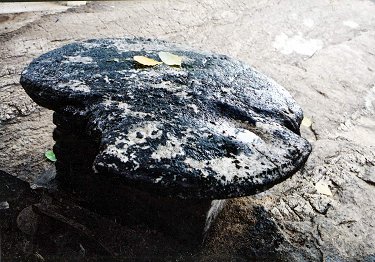
Chatra gala, a circular stone of a three and a half metre diameter used in place of umbrella
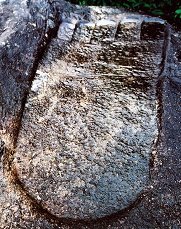
The imprint of the footprint of the Buddha carved on the summit of the rock near dāgaba
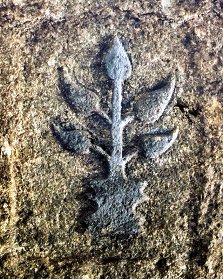
A carved bas-relief of Bo-tree
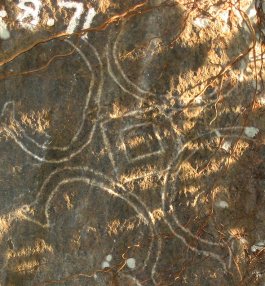
This symbol would denote that the true doctrine may endure in the world, bringing illumination to mankind from ignorance and suffering and that it be open wide to the all four directions
The ‘sanded bench’ (welipillama) is another artifact at Aluvihāra. During the primitive times, apprentices were first taught to write with the tip of their forefinger on the leveled sand of this bench. They had to practice this skill in writing the Siņhala alphabet before proceeding with the writing of Holy Scriptures on palm-leaves with the stylus. While writing, on this sand bench, the apprentice spelled each consonant rhythmically followed by the proper vowel. Each consonant with the proper vowel denotes that how consonant fixes with a vowel. Here, vowels are suppressed leaving the consonant. Unlike English, the vowels are spelled separately in Singhalese. Therefore, Sri Lankan characters have headpieces, foot pieces and sidepieces.
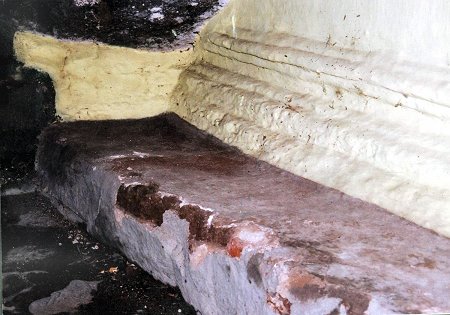
Figure (10) Sanded bench where apprentices were first taught to write with the tip of their forefinger on the leveled sand
The earliest inscriptions, which have been discovered already in Sri Lanka, are in the Brahami characters. “The earliest Singhalese inscriptions use a script known as the “Brahami lipi” confirms Dr Wilhelm Geiger. Rock caves bearing thousands of such short Brahami inscriptions are in many regions in the island with hewn drip-ledges on the brows of the rock caves diffusing from the 3rd century B.C, to the 1st Century A.C. Many books on Buddhism including the Singhalese commentaries must have been originally written in those letters on palm-leaves. The same characters may have been used in the writings done at Aluvihāra and also in the case of Pāli commentaries written in 432 AC. Aluvihāra temple too, claims such Brahami inscriptions inscribed on the rock cave facades, which belong to the 2nd century B.C. All caves at Aluvihāra had been forest dwellings. Some caves have these Brahami inscriptions on them.
The Brahami inscriptions edited by Professor Senararh Paranavitāna at Aluvihāra are as follows,
No.820 [1] (Upasaka Sumanaha……………..Deva teraha lene
The cave of the lay devotee Sumana and of the elder Deva
No.821 [2] Sivagutaha
Of Sivagutta
No.822 [3] (1) Vasaha Summa……………..ra adi
(2) na ha na
Of Vamsa Suma …………..the canal
● Bata Magalasha………. Lene
The cave of Chief Mangala
(A lately discovered inscription)
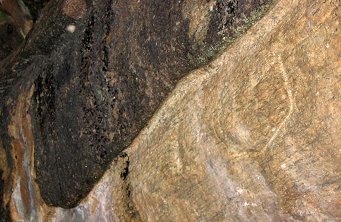
Dripe-ledge (narrow horizontal line cut on the brow of the cliff in order to prevent water dripping into the cave)
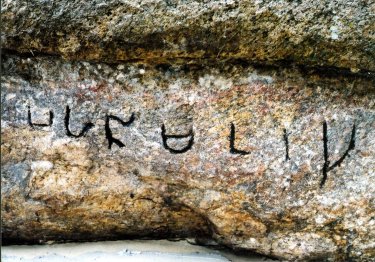
Brahami inscriptions hewed on the rock cave façade which bear testimony that these caves were dedicated to recluses
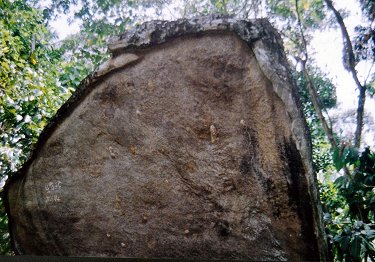
One of the solitary caves located about 1km away from the cave complex of Aluvihāra called ‘frog-like-cave’
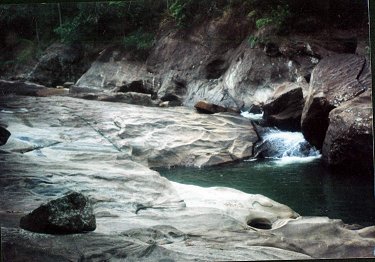
Rocky-bath-tub located nearly 7 km away in Rattota (tub of Arahants) used by the Arahants convened for the Buddhist council at Aluvihāra
Lately, more inscriptions were discovered from Aluvihāra temple complex, but they have not been published so far. The inscriptions, already discovered at Aluvihāra, authenticates the antiquity of the caves similar to the caves found at Dambulla, Mihintale Ambulambe, Neluvākanda, Embilla, Kohona, Ganegedara, Hulangamuva, Rusigama, Talgahagoda, Demada Oya and Ridī Vihāra ( except Ridī Vihāra, all located in the district of Mātale). All these rock caves according to these inscriptions, had been donated to the saņgha, of the four quarters, present and absent by kings, local rulers, regional chieftains and other devotees.
Home | Significance | Access | History | Artifacts | Contact Us | Appendix I | Appendix II | Appendix III
©1996-2011 Copyright Mahendra Gunaratne, Virus Inc. All Rights Reserved www.virusinc.org virusinc@gmail.com +94 777 783468